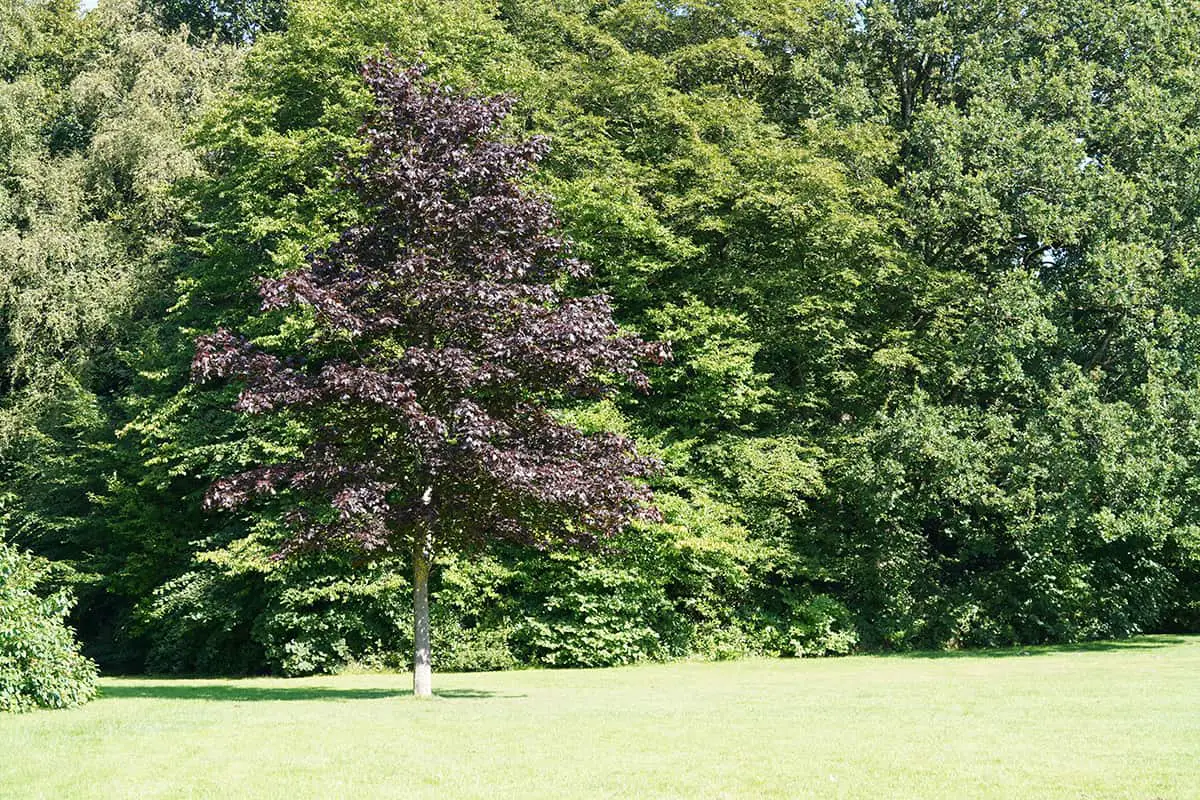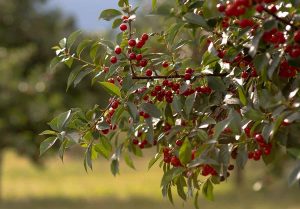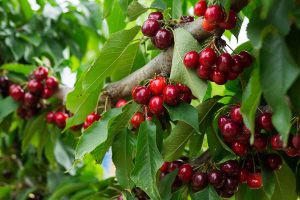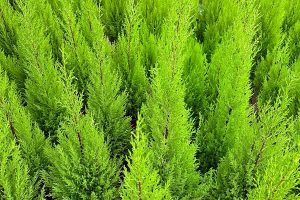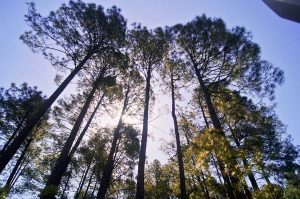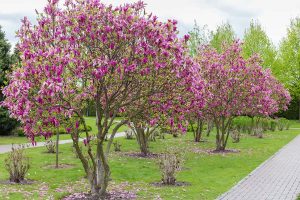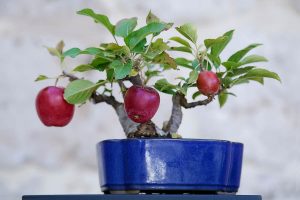Maple trees belong to the Acer genus and are widely known for their glorious fall foliage colors and heavily lobed leaves.
Despite being deciduous, most Acer species also offer interest throughout the winter thanks to their interesting bark. Here we look at some of the best types of Maple trees for growing in a range of climates.
Table of Contents
Bigleaf Maple
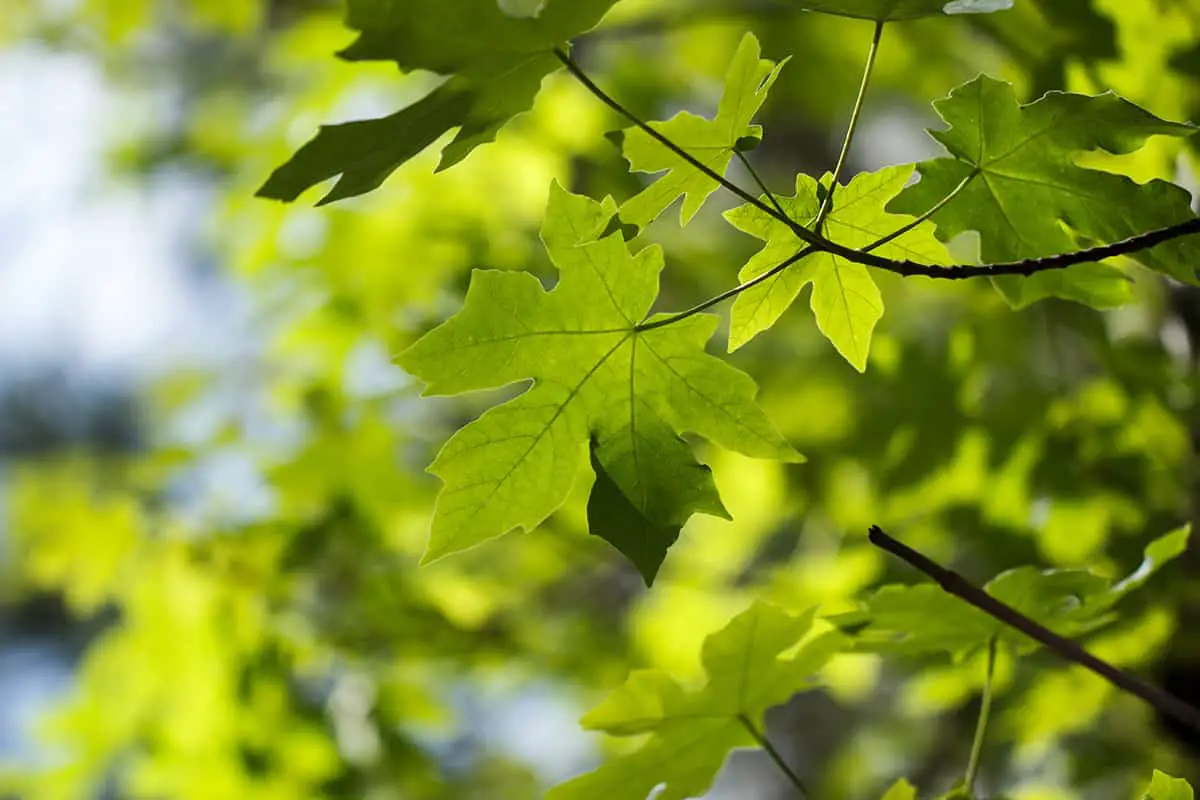
- Botanical name: Acer macrophyllum
- Common names: Bigleaf Maple, Oregon Maple,
- Plant family: Sapindaceae
- USDA hardiness zone: 3 – 8
- Mature height: 50 to 70 feet
- Mature spread: 50 to 70 feet
This is a North American native tree, growing predominantly across the Pacific coast. It is large in stature, most commonly reaching heights of around 60 feet, with a similar-sized spread, though there are examples of Bigleaf Maples getting as tall as 150 feet. The largest living example in the world of a Bigleaf Maple is in Oregon, USA.
The tree stands at just under 120 feet in height, with a massive spread of 91 feet. In maple trees of this size, individual leaves can span as much as 2 feet across, though leaves measuring 1 foot in width are more common on average Bigleaf Maples. The foliage of the Bigleaf Maple is larger than that of any other type of maple, which is the reason behind this species’ common name.
Like most maple trees, the leaves of the Bigleaf Maple warm up to shades of yellow and orange towards the latter end of the year, before falling to the ground. By winter time, the branches of the Bigleaf Maple have no leaves, but the fruits which have followed clusters of small yellow flowers will persist on the tree, dangling like small ornaments.
The Bigleaf Maple usually lives for between 50 and 200 years and is important for local wildlife. It creates shelter and cover for birds and wild mammals, and elk, beavers, and deer graze on the foliage. It occurs frequently in moist habitats such as coastal regions, riverbanks, alongside streams, and damp woodlands.
Bigleaf Maple trees thrive in full sun or partial shade. They need a well-draining soil type, ideally clay or loamy soils, though it will adapt to sandy soils. The soil should be kept moist for the best growth.
Sugar Maple
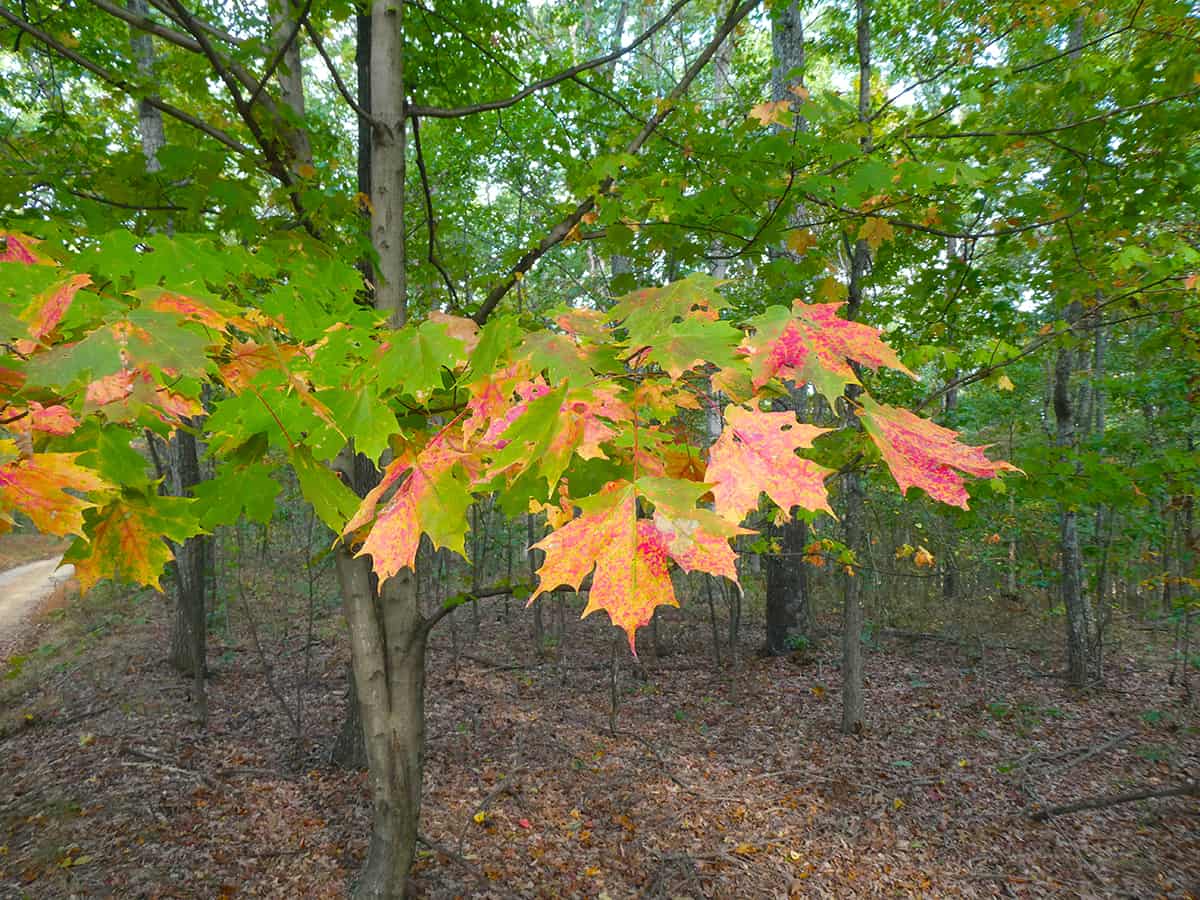
- Botanical name: Acer saccharum
- Common names: Sugar Maple, Northern Sugar Maple, Striped Maple, Rock Maple, Hard Maple, Sweet Maple
- Plant family: Sapindaceae
- USDA hardiness zone: 3 – 9
- Mature height: 60 to 100 feet
- Mature spread: 50 to 80 feet
The Sugar Maple is native to forests in both Canada and the United States, though it is widely considered to be a symbol of Canada. It is also the state tree of Wisconsin, Vermont, West Virginia, and New York. The Sugar Maple gets its common name from the fact that its sap is sweet and sugary, and this is the tree that is used to produce maple syrup.
As well as being famed for its production of maple syrup, the Sugar Maple is also favored for its spectacular color-changing leaves. The foliage of this deciduous tree starts out medium green and deepens to a darker shade of green in the summer. As fall descends, the green leaves take on a dark burgundy color before moving on to bright, scarlet red.
They then fade to a burnt orange, and subsequently a vivid orange-yellow, before eventually turning gold and dropping to the ground. Despite being a deciduous tree, the Sugar Maple retains an interest in the landscape through winter with its furrowed gray bark which becomes more heavily ridged with age.
Sugar Maples are commercially important as a source of maple syrup, and also for their timber which is considered desirable because of the creamy color, and the strength of the wood. Sugar Maple trees make for excellent shade trees and are widely planted in parklands.
Sugar Maple trees are low maintenance, and they grow fairly quickly and easily in ideal conditions. They enjoy well-drained soils with a moderate moisture level, and will struggle in soils which are too wet or too dry. They can adapt to any type of lighting and will thrive in both full sun or full shade, though leaf scorch can happen in full sun if the soil is not moist enough.
Norway Maple
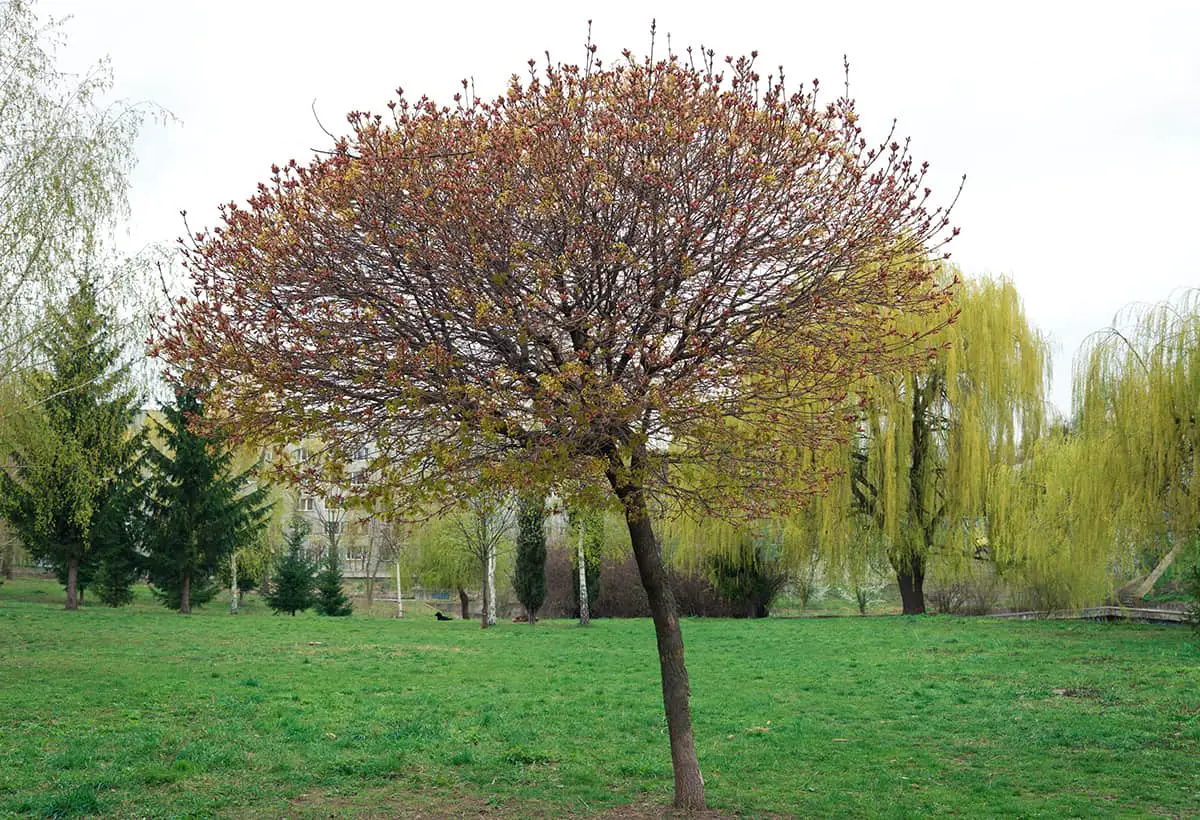
- Botanical name: Acer platanoides
- Common names: Norway Maple, Plane-leaved Maple
- Plant family: Sapindaceae
- USDA hardiness zone: 3 – 7
- Mature height: 50 to 80 feet
- Mature spread: 40 to 60 feet
The Norway Maple is native to Europe and parts of Asia, though it was introduced to North America in the 18th century as a shade tree, and has since naturalized and even become invasive in some areas. It has been reported as invasive in Maine, Maryland, Pennsylvania, and Virginia, and therefore advice should be sought before cultivating this tree in these regions.
The tree is known to have a shallow root system which deprives nearby plants of the moisture and nutrients they need to thrive, and it also has vigorous roots which cause major issues with underground sewer systems and structural foundations. The Norway Maple has been banned from being sold in New Hampshire and Massachusetts.
In many parts of North America, the Norway Maple is planted as a park tree or landscape tree and is often mistaken for the Sugar Maple. Like many maple trees, the Norway Maple has striking foliage that changes color throughout the seasons. It features a slender, gray trunk, and a lush, rounded canopy.
The Norway Maple is very low maintenance and easy to grow. It will thrive in a range of soil types and can survive through extended periods of drought, though it prefers moist growing conditions.
Amur Maple
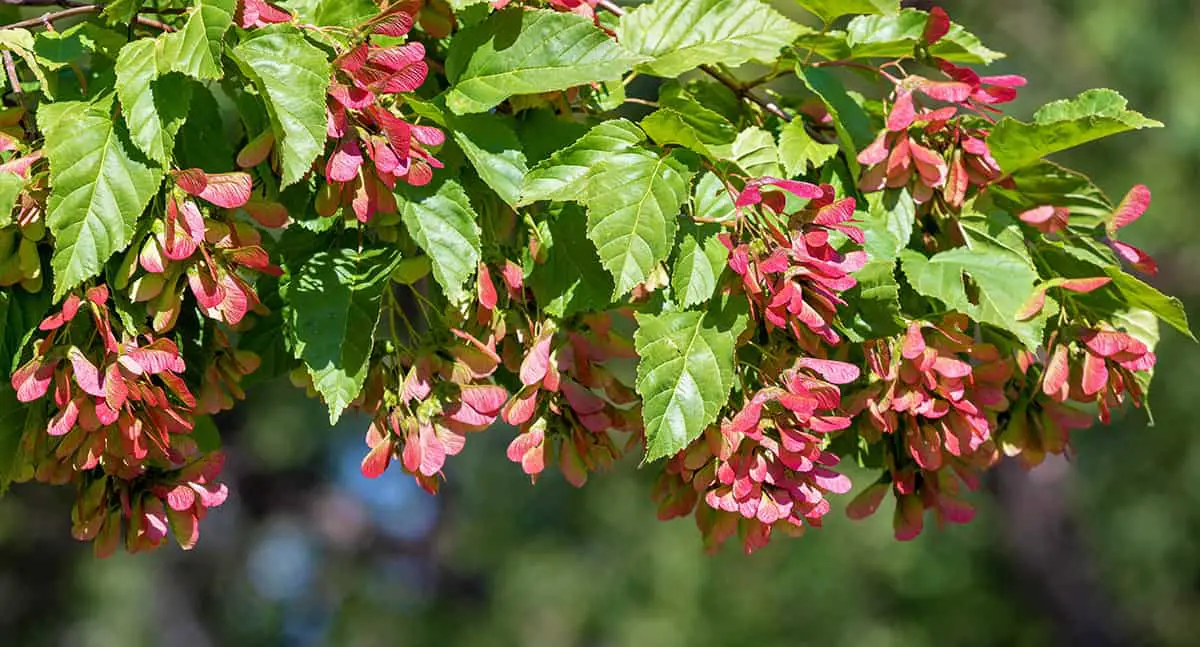
- Botanical name: Acer ginnala
- Common names: Amur Maple
- Plant family: Sapindaceae
- USDA hardiness zone: 3 – 7
- Mature height: 15 to 20 feet
- Mature spread: 15 to 20 feet
This tree is native to Korea, Japan, and China, and is a deciduous maple which can be grown as a large shrub or small tree. It is ideal for compact spaces, where it can add interest throughout the year while remaining a relatively small size. It is well suited to life in a container and therefore works well as a patio tree.
Like most maple species, the Amur Maple exhibits color-changing leaves through fall, which usually turn from green to red but in some cases will change from green to yellow. The tree produces fragrant clusters of flowers in a creamy color during summer, and these are followed by brightly colored winged samaras in the fall. The samaras are a visually striking addition to the tree, in bright red or vivid pink, and they dangle from the tree like colorful baubles.
The Amur Maple can be grown in full sun or partial shade. It prefers moist, well-draining soils, but it can adapt to drought.
Japanese Maple
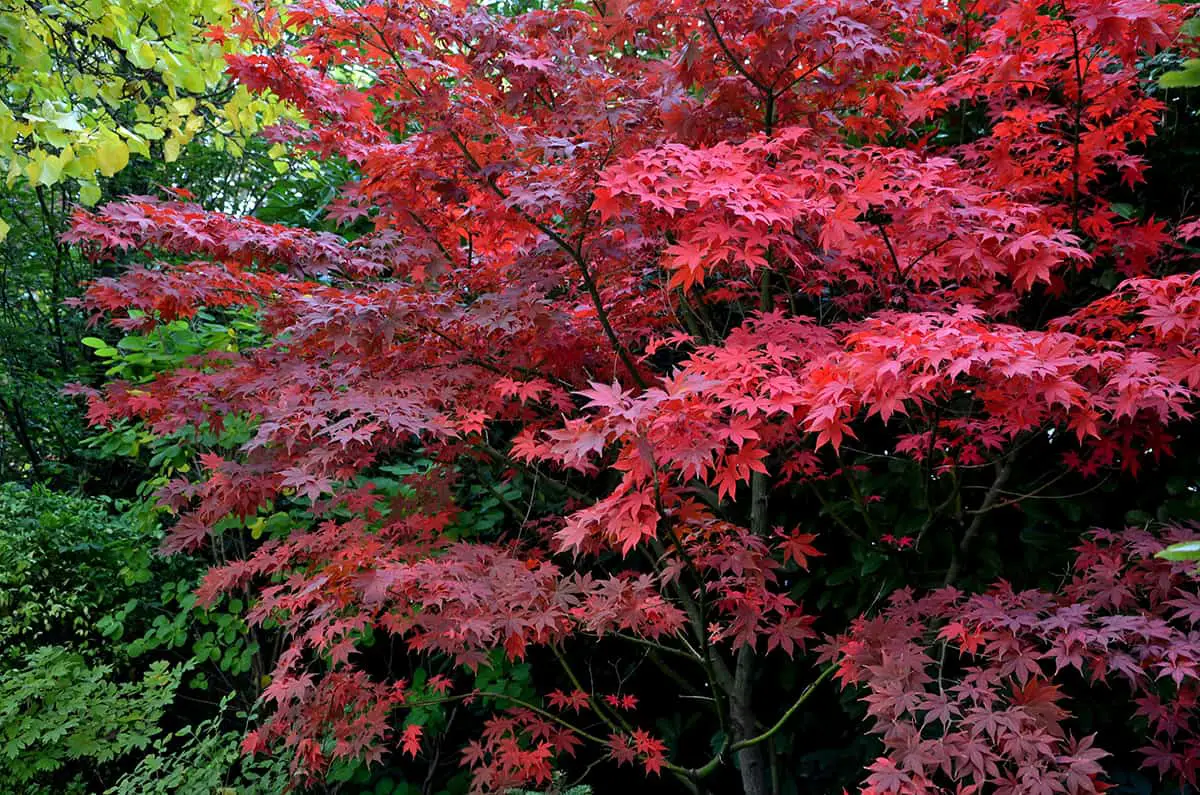
- Botanical name: Acer palmatum
- Common names: Japanese Maple, Smooth Japanese Maple, Palmate Maple
- Plant family: Sapindaceae
- USDA hardiness zone: 5 – 9
- Mature height: 4 feet to 30 feet
- Mature spread: 3 feet to 25 feet
Japanese Maples come in a wide range of cultivars, with reportedly more than 1000 different varieties of Japanese Maples having been bred throughout the years by breeders and collectors. Some varieties exhibit unusual features, such as the Acer palmatum ‘Ukigumo’ which produces pale pink foliage, and the Acer palmatum ‘Emerald Lace’ which has lacy, almost fern-like foliage.
The Acer palmatum ‘Elegans’ is known for its serrated leaf margins and salmon-pink spring foliage, and the Acer palmatum ‘Coral Bark’ is favored for its vivid orange-red branches and stems. One of the more popular varieties of Japanese Maple is the Acer palmatum ‘Crimson Queen’, a recipient of the Award of Garden Merit from the Royal Horticultural Society, whose leaves emerge crimson red in spring and remain this way right into summer before changing to green.
The different varieties of Japanese Maple can range in size from as small as 4 feet tall at mature height, up to 30 feet tall, making them a great choice for a range of different garden types and settings.
Japanese Maple trees can be grown in full sun to partial shade, though the best foliage color will usually occur in shaded environments. Leaf scorch can be a problem in full sun if the soil is not kept moist, so use bark to keep roots cool and prevent moisture from evaporating.
Florida Maple
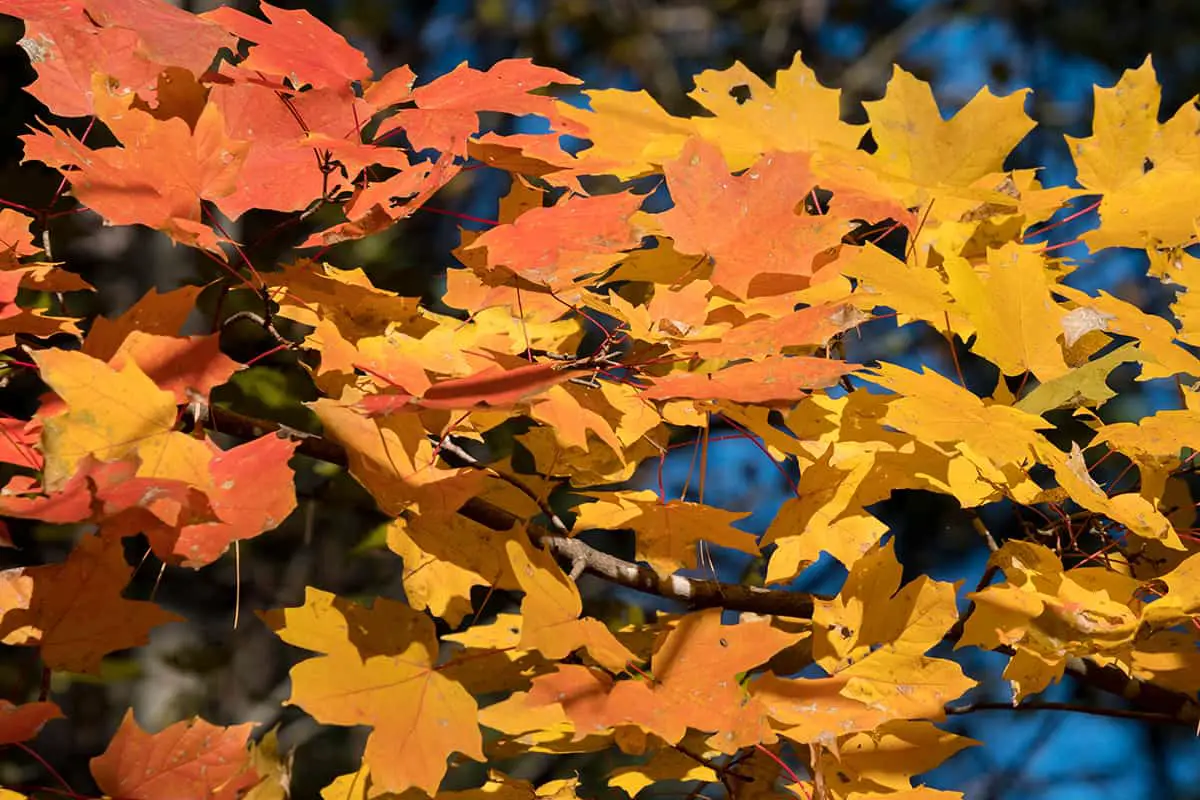
- Botanical name: Acer floridanum
- Common names: Florida Maple, Hammock Maple, Southern Sugar Maple, Rock Maple, Caddo Maple
- Plant family: Sapindaceae
- USDA hardiness zone: 6 – 9
- Mature height: Up to 60 feet
- Mature spread: Up to 50 feet
The Florida Maple is native to woodlands in the southern states of the US. It is sometimes known as the Southern Sugar Maple because it is closely related to the Sugar Maple and bears a close resemblance, however, the Florida Maple is significantly more tolerant of heat. Like most maple trees, the Florida Maple puts on a show-stopping display of color in the fall, when leaves transform from green through to red, orange, and yellow, before they are shed from the tree.
The Florida Maple remains attractive throughout winter when the branches are bare, thanks to the gray bark which becomes more gnarled as the tree ages. The flowers of the Florida Maple arrive in dense clusters as tiny yellow or green blossoms, and they will emerge along the bare branches in early spring before the leaves make an appearance, or they will bloom at the same time as the leaves are just opening up.
Florida Maple trees are an excellent alternative to the Sugar Maple in more southern climates since they tolerate higher levels of heat and are also much more tolerant of drought. They provide excellent shade through the summer months, and are an important source of shelter and food for a variety of different wildlife.
Florida Maples thrive in full sun or partial shade. They prefer well-draining, fertile soil which is slightly acidic, however, they will adapt to a wide range of soil types and are tolerant of dry conditions. The Florida Maple is not suitable for planting in coastal regions since it is not tolerant of salt.
Red Maple
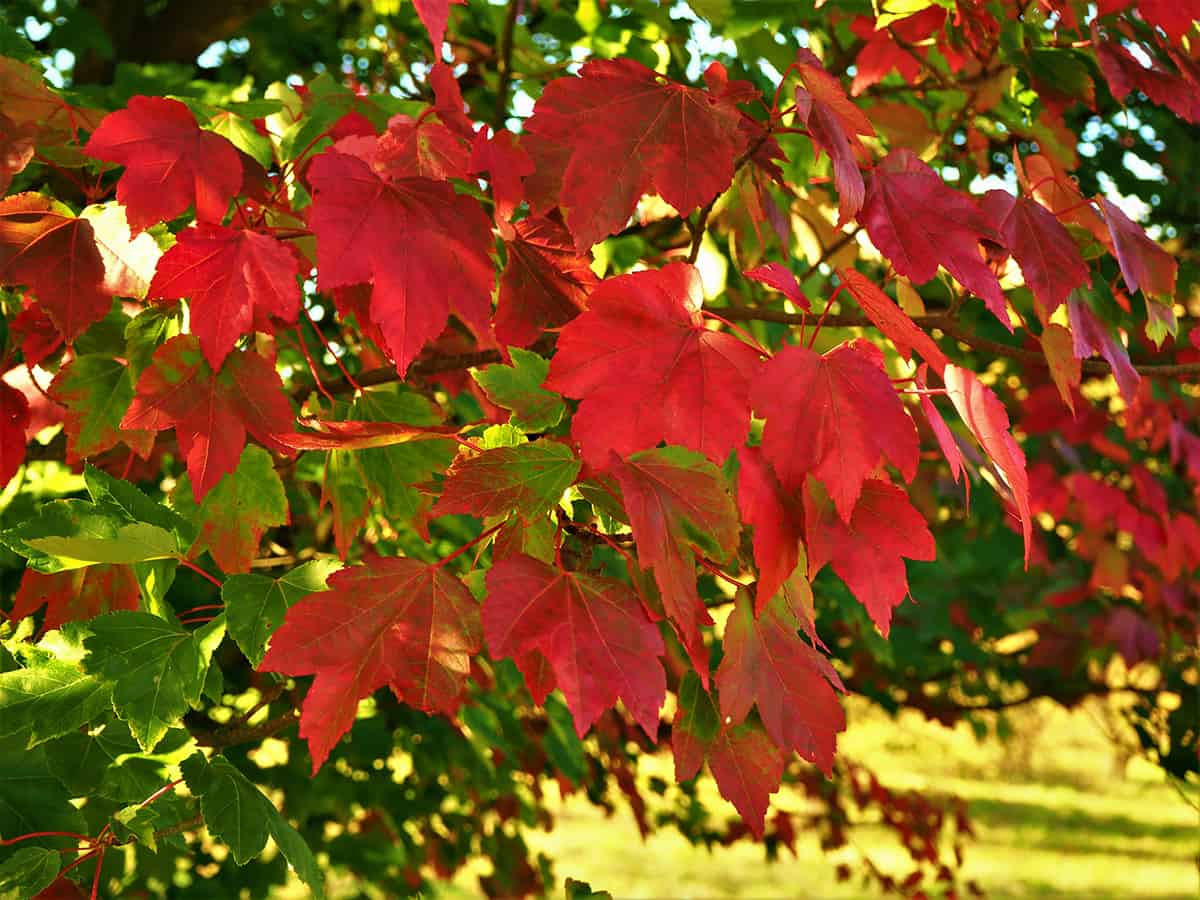
- Botanical name: Acer rubrum
- Common names: Red Maple, Swamp Maple, Canadian Maple, Scarlet Maple
- Plant family: Sapindaceae
- USDA hardiness zone: 3 – 9
- Mature height: 70 to 120 feet
- Mature spread: 30 to 80 feet
Red Maple trees are native to central and eastern North America, and they are regarded as the most common of all deciduous trees in eastern North America. The Red Maple is red in many senses. In spring it produces clusters of tiny red flowers which bloom along bare branches before the emergence of the leaves. In summer, the red flowers develop into red fruits.
The foliage of the tree unfurls in mid to late spring and is flushed red at first, and it then develops to dark green. In fall, the leaves once again take on a bright red color, and fade to orange and yellow, before dropping to the ground. The crown of the tree is usually pyramid-shaped when young, but as the tree ages it will take on a more oval or rounded shape.
With a great height and widespread, the Red Maple makes an excellent shade tree through summer, and therefore is very popular as a park and sidewalk tree, as well as a landscape tree grown for interest through every season. In the winter, the deeply furrowed, thick, gray bark can be appreciated, which is usually hidden beneath the leaves.
Red Maple trees thrive in full sun or partial shade. They prefer well-draining, moist soils, but they can adapt to a range of soil types. The Red Maple is also known as the Swamp Maple because it is tolerant of wet or waterlogged soils. It does not do well in drought, and soil should be kept moist to wet.
Vine Maple
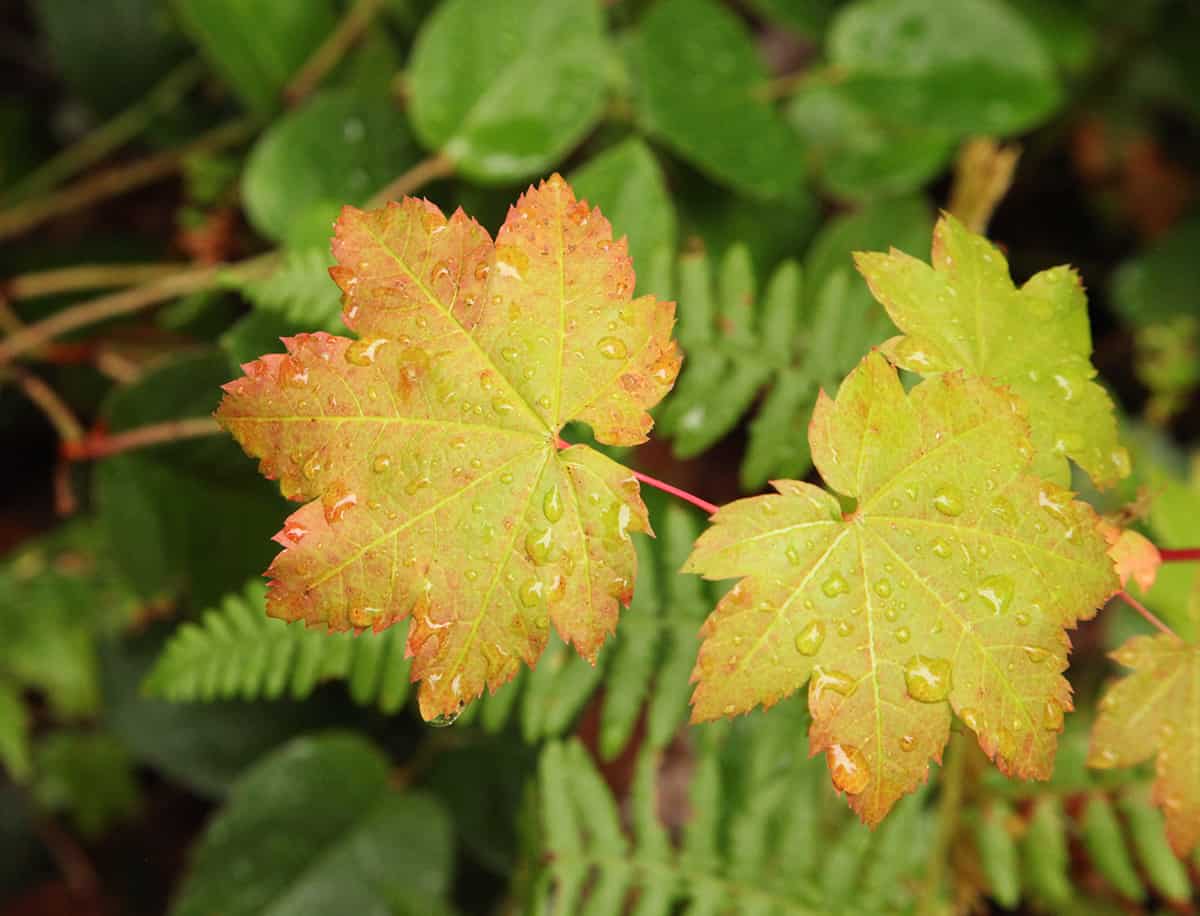
- Botanical name: Acer circinatum
- Common names: Vine Maple
- Plant family: Sapindaceae
- USDA hardiness zone: 6 – 9
- Mature height: 25 feet
- Mature spread: 15 to 20 feet
The Vine Maple is native to western North America, from British Columbia in Canada down to California in the United States. It is a deciduous maple with a spreading habit, which can be grown as a shrub or small tree. When grown in shady conditions, the Vine Maple tends to grow sideways, whereas, for a more upright habit, it should be positioned in full sun.
As a shrub, the plant will be multi-stemmed, and as a tree, it can have multiple trunks or be trained into growing one trunk by removing the smaller or weaker stems when the plant is young. The leaves of the Vine Maple are noted for being as wide as they are long, with an almost circular, lobed shape.
They are green through summer, and take on dazzling shades of orange and red in the fall. Vine Maple trees produce pretty purple flowers which arrive in small clusters in spring, and these are followed by winged samaras in bright red. These are considered irresistible to birds and wild mammals and do not hang around on the tree for long before they get consumed by local wildlife.
Vine Maple trees and shrubs can be grown in full sun or partial shade, and they love well-draining soils which are kept moderately moist. These trees will struggle in hot and dry climates, so ensure the soil is kept moist during hot summers, especially if there is no shade.
Paperbark Maple

- Botanical name: Acer griseum
- Common names: Paperbark Maple
- Plant family: Sapindaceae
- USDA hardiness zone: 4 – 8
- Mature height: 30 feet
- Mature spread: 25 feet
The Paperbark Maple is a deciduous tree which is native to China. It is named after the brown bark, which peels away in tight curls to reveal a rich, cinnamon color beneath. Unlike many exfoliating trees which only start to peel as they mature, the Paperbark Maple will peel on the trunk, branches, and stems, even from a young age.
The foliage of the tree is also very appealing, with leaves which are green on top and blue underneath through the summer, and these then develop to intense shades of red, orange, and gold in the fall. The Paperbark Maple grows quite slowly, and even at full height will not usually exceed 30 feet tall. It is a great choice of deciduous tree for year-round interest and is considered something of a collector’s item amongst gardeners who enjoy species which have exfoliating bark.
Paperbark Maple trees are easy to care for, and are low maintenance, requiring little if any pruning throughout their lifetime. The tree should be situated in full sun or partial shade, in soil which is well draining. Maintaining moist soil is a must for this tree because it cannot tolerate drought. Mulching over the soil will help to keep the roots cool and preserve moisture content to avoid dry conditions.
Sycamore Maple
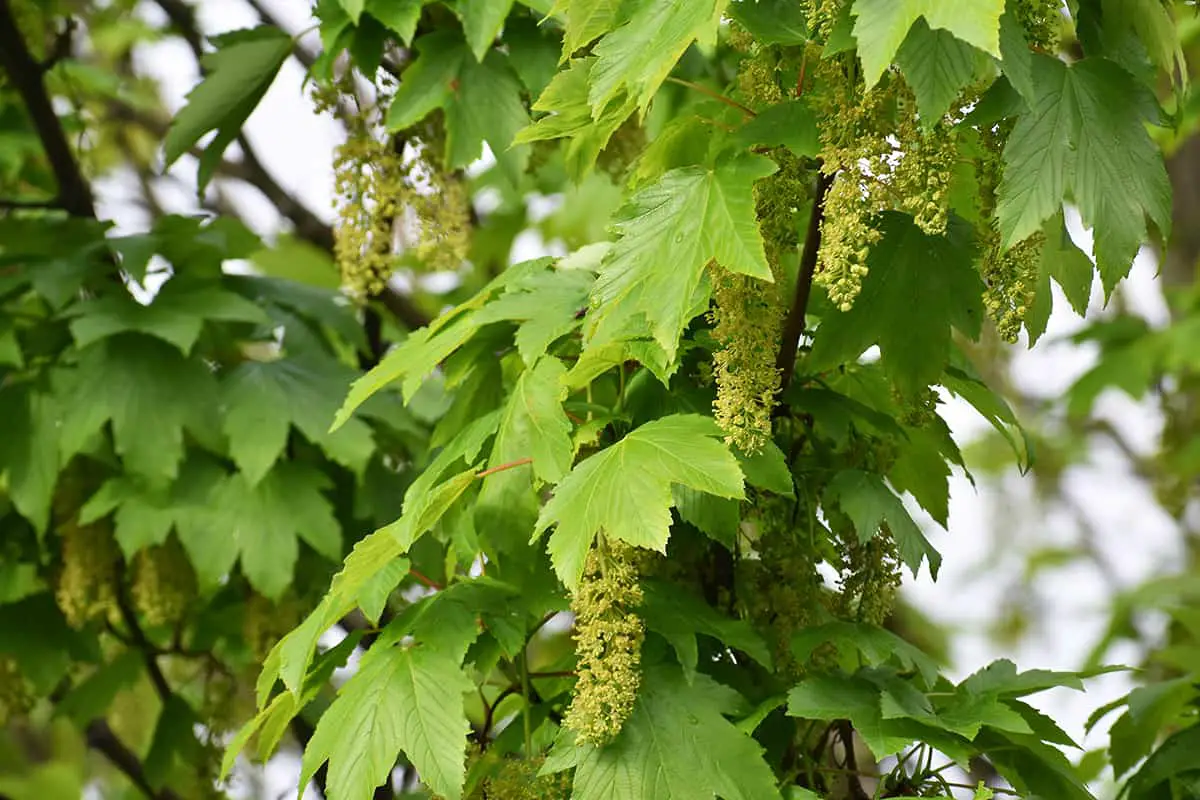
- Botanical name: Acer pseudoplatanus
- Common names: Sycamore Maple
- Plant family: Sapindaceae
- USDA hardiness zone: 4 – 7
- Mature height: 100 feet
- Mature spread: 60 feet
This is a deciduous tree native to Asia and central, southern, and eastern Europe. In North America it is known as the Sycamore Maple, though in the UK it is known simply as a ‘Sycamore’. It is not native to the UK but has become naturalized in this region due to the rapidly spreading nature of the plant, which results from the highly fertile seeds it produces.
The Sycamore Maple is a long-lived tree, which can live to 500 years old. It is a large species, which can exceed 100 feet in height, though more commonly tops out at between 80 and 100 feet. The leaves of the tree emerge in a salmon shade of pink in spring and develop to a fresh shade of green by summer. Like most maple species, the leaves will warm up to shades of red and orange in the fall before dropping to the ground.
The bark of the tree is a pink-hued gray color, and the stems and branches are pink-brown. The flowers of the Sycamore Maple arrive in spring and are yellow-green, clustered together in spike-shaped racemes which dangle from the tree. These develop into winged fruits called samaras, which have a distinctive ‘V’ shape and are ravished by birds and small mammals.
Sycamore Maple trees thrive in woodland environments, in fertile, well-draining soils which are moist or damp. They can grow in full sun or partial shade.
Three-Flowered Maple
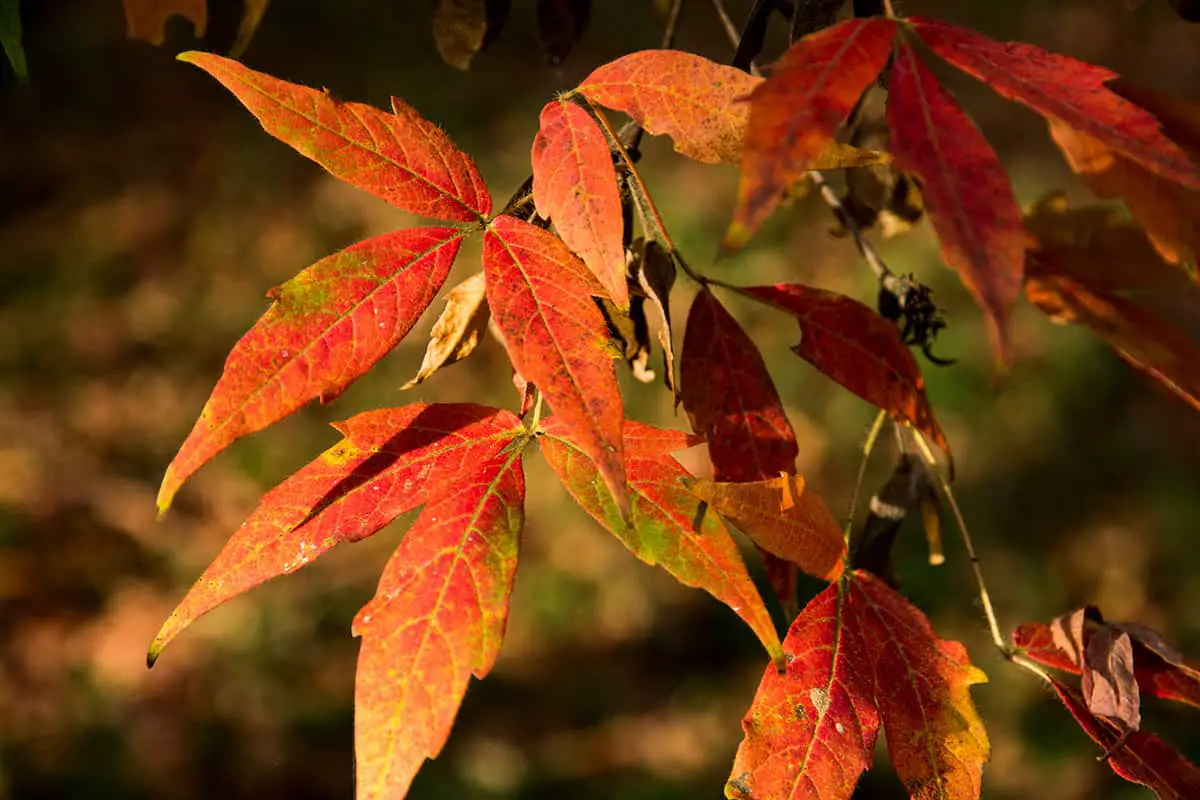
- Botanical name: Acer triflorum
- Common names: Three-Flowered Maple
- Plant family: Sapindaceae
- USDA hardiness zone: 5 – 7
- Mature height: 20 to 80 feet
- Mature spread: 20 to 50 feet
The Three-Flowered Maple is a small to a medium-sized tree which is native to Korea and China. It is capable of reaching heights of up to 80 feet though usually tops out at around 20 to 30 feet. Like the Paperbark Maple, the Three-Flowered Maple is known for its exfoliating bark, however, the bark of this tree does not peel away in papery ribbons like the Paperbark Maple and instead sheds in small chunks or strips.
The pale brown bark reveals a copper-toned smoother bark underneath, adding interest to the landscape through the winter when the tree has lost its leaves. The tree is named after its small yellow flowers, which arrive in sets of three. These develop into winged samaras which have a hairy covering. As is common with maples, this tree has lobed leaves which produce striking fall colors of red, orange, gold, and purple.
The Three-Flowered Maple thrives in both full sun and heavy shade and is known for being a species that develops intense fall colors even with minimal exposure to the sun.
It grows easily in soils which are well draining and kept moist or damp. It cannot tolerate drought, so mulching is recommended in warmer climates to prevent the evaporation of moisture and to keep the roots cool.
